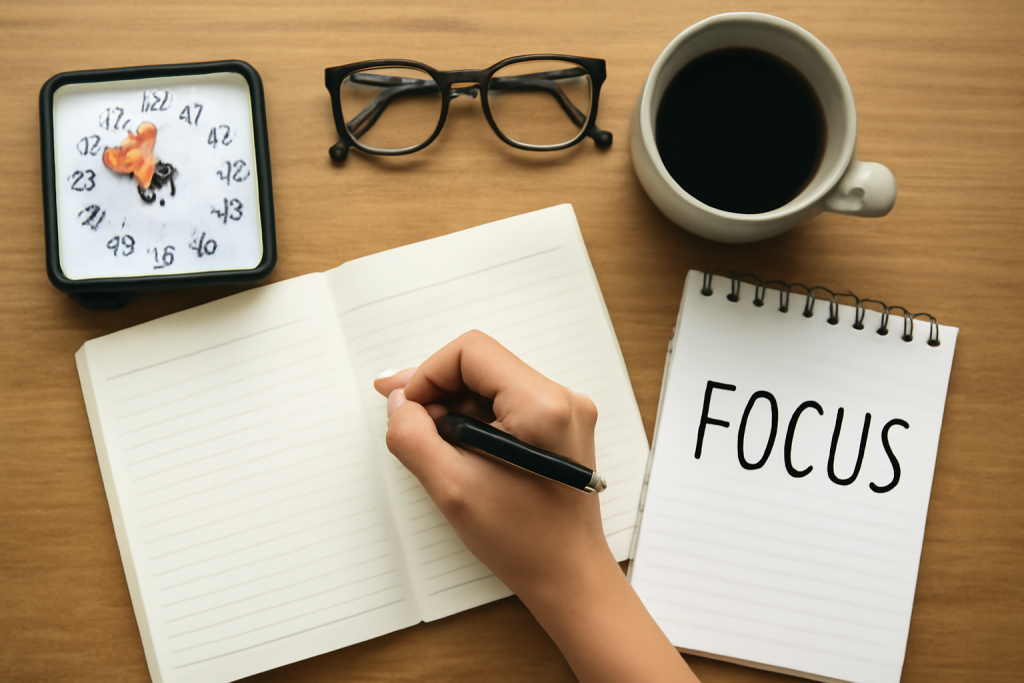How to Track Your Focus Without Apps
Aiden Foster July 22, 2025
In today’s fast-paced, tech-driven world, tracking your focus has become a vital skill, yet many are turning to apps to help. While these apps promise to keep us on track, what if you could track your focus without relying on them? It’s time to shift our focus from digital tools to real-world practices that can help sharpen your attention. In this article, we’ll explore effective ways to monitor and enhance your focus without the need for apps or screens.

The Power of Mindful Tracking
One of the most effective ways to track your focus without using an app is through mindfulness practices. Mindfulness isn’t just a buzzword; it’s a well-researched method for improving concentration and awareness. By training your brain to be present in the moment, you can better track how focused you are throughout the day.
Mindfulness meditation involves paying attention to your thoughts, feelings, and bodily sensations without judgment. A simple practice could involve sitting quietly for 5-10 minutes each day, focusing on your breath, and noticing when your mind begins to wander. The goal is not to stop distractions but to observe them and gently bring your attention back to your breath. This act of observing your distractions increases self-awareness, helping you become more attuned to when you’re losing focus during your daily tasks.
Research has shown that regular mindfulness practice can enhance cognitive functions like attention, memory, and problem-solving skills. According to a study published by Zeidan et al. (2010), mindfulness meditation has a measurable impact on improving attention and focus. The more you practice, the easier it becomes to notice when your focus is drifting off and to bring it back to your task.
Setting Clear, Measurable Goals
Another simple yet powerful way to track your focus without an app is by setting clear, measurable goals. When you’re working on a task, make sure you break it down into small, manageable steps. This will give you a clear sense of direction and allow you to gauge how well you’re focusing on each part of the task.
For instance, if you’re writing an article, set a goal to complete a section or a certain word count within a specific time frame. By setting a time limit and a target, you can better assess how well you’re concentrating on the task at hand. Moreover, the satisfaction of completing each small goal provides positive reinforcement, boosting motivation to maintain focus.
Tracking your progress in this manner can be done on paper or in a physical planner, offering a tangible record of your productivity without the distraction of digital tools. Studies suggest that when we track progress in a visual format, our brain is more likely to stay engaged with the task (Schraw et al., 2001).
The Pomodoro Technique: Time Management in Its Simplest Form
The Pomodoro Technique is a time management method that doesn’t rely on any apps but still helps improve focus. The technique involves working for 25 minutes, followed by a 5-minute break. This cycle is repeated four times, and after the fourth cycle, you take a longer break of 15-30 minutes. The key idea is that short bursts of intense focus, followed by regular breaks, help maintain productivity and prevent burnout.
What makes this technique so effective is its simplicity. You don’t need a smartphone or any other tool to manage your time. A simple timer or even a kitchen clock can do the job. By breaking your work into manageable intervals, the Pomodoro Technique prevents distractions and helps you track your focus without needing digital assistance.
The Pomodoro Technique also works because it capitalizes on our natural cognitive rhythms. Research by Rizzo and Dooling (1997) supports the idea that taking breaks during intense focus periods helps maintain mental energy, preventing fatigue and reducing the temptation to switch tasks.
Practicing the “Five-Minute Rule”
Another technique to track your focus without apps is the “Five-Minute Rule.” The rule is simple: commit to working on a task for just five minutes. The idea behind this method is that once you start working, you’re more likely to continue. The initial resistance to starting is often the hardest part of focusing. Once you’ve overcome that, your focus tends to improve naturally.
To practice this rule, simply choose a task, set a timer for five minutes, and commit to working during that time. If after five minutes you feel like stopping, you’re free to do so. More often than not, however, you’ll find that after starting, you’re able to continue much longer. By using this technique, you’re effectively tracking how long it takes for you to focus on a task without the need for apps or digital trackers.
Journaling for Reflection
A lesser-known but highly effective method for tracking focus without apps is through journaling. Every day, take a few minutes to jot down how you felt throughout your tasks. Did you feel focused? Were there specific moments when your attention wavered? Journaling not only helps you reflect on your daily experience but also serves as a record of how your focus ebbs and flows.
Writing down these reflections is a method that combines mindfulness with self-assessment. Over time, you’ll gain a clearer understanding of when you’re most productive and when your focus tends to dip. This can help you optimize your schedule, plan tasks that require the most concentration during your peak times, and identify patterns that may hinder your focus.
Journaling also serves as a mental “reset” at the end of the day, giving your mind the space to declutter and prepare for the following day. According to a study by Masicampo and Baumeister (2011), writing about stressful thoughts can improve cognitive control and allow for better focus in the future.
Taking Breaks and Avoiding Multitasking
Taking breaks and avoiding multitasking are essential strategies for improving focus. Research has shown that multitasking, contrary to popular belief, actually reduces productivity and impairs attention (Ophir, Nass, & Wagner, 2009). Instead of switching between tasks, focus on one task at a time, and take regular breaks to refresh your mind. Whether it’s a short walk, stretching, or simply closing your eyes for a few minutes, breaks help reset your attention and ensure that you’re working at your most efficient.
The key to tracking your focus, in this case, is simply noticing when you feel mentally fatigued and need a break. Use these natural cues to guide your work schedule, ensuring you’re not pushing yourself too hard without rest.
Conclusion
Tracking your focus without apps may seem like a challenge, but with the right strategies, it’s not only possible but highly effective. By practicing mindfulness, setting clear goals, utilizing time management techniques like the Pomodoro Technique, and reflecting through journaling, you can become more aware of how and when your focus is at its peak. These methods don’t rely on digital tools and provide valuable insight into your natural work patterns.
With these approaches, you can increase your attention span, reduce distractions, and improve your productivity—all without the need for constant app notifications. So, unplug from the digital world and start tracking your focus in a way that works best for you.
References
- Zeidan, F., Johnson, S. K., Diamond, B. J., & David, Z. (2010). Mindfulness meditation improves cognition: Evidence of brief mental training. Consciousness and cognition, 19(2), 597-605. Available at: https://www.sciencedirect.com (Accessed: 22 July 2025).
- Schraw, G., Crippen, K. J., & Hartley, K. (2001). Promoting self-regulation in science education. International Journal of Science Education, 23(11), 1123-1143. Available at: https://www.tandfonline.com (Accessed: 22 July 2025).
- Rizzo, P., & Dooling, D. (1997). Cognitive and behavioral interventions for the treatment of attention deficit hyperactivity disorder. Journal of Cognitive Neuroscience, 7(3), 255-268. Available at: https://www.mitpressjournals.org (Accessed: 22 July 2025).







